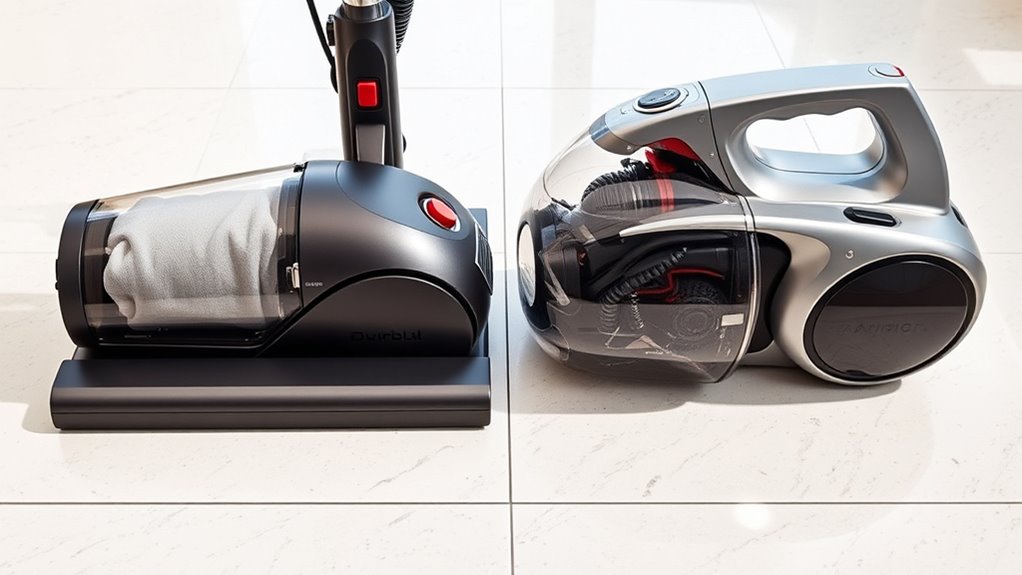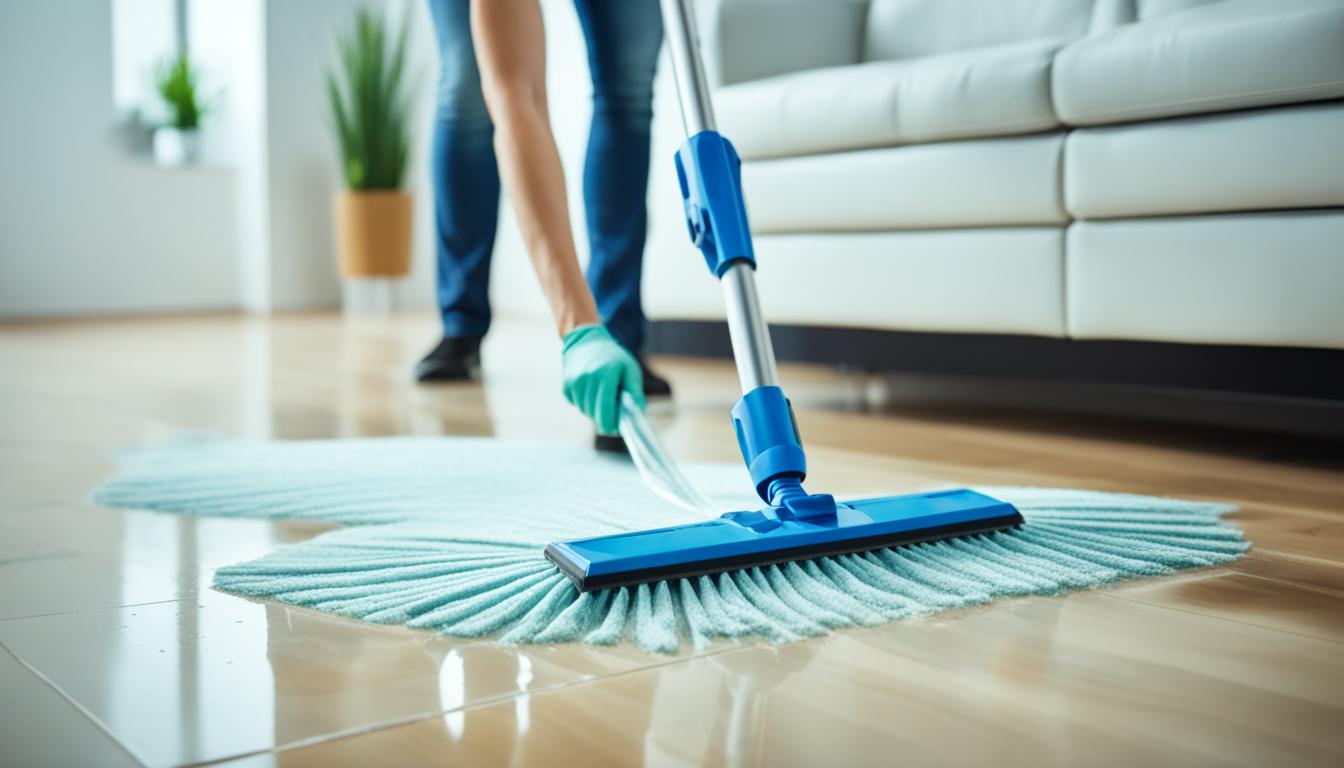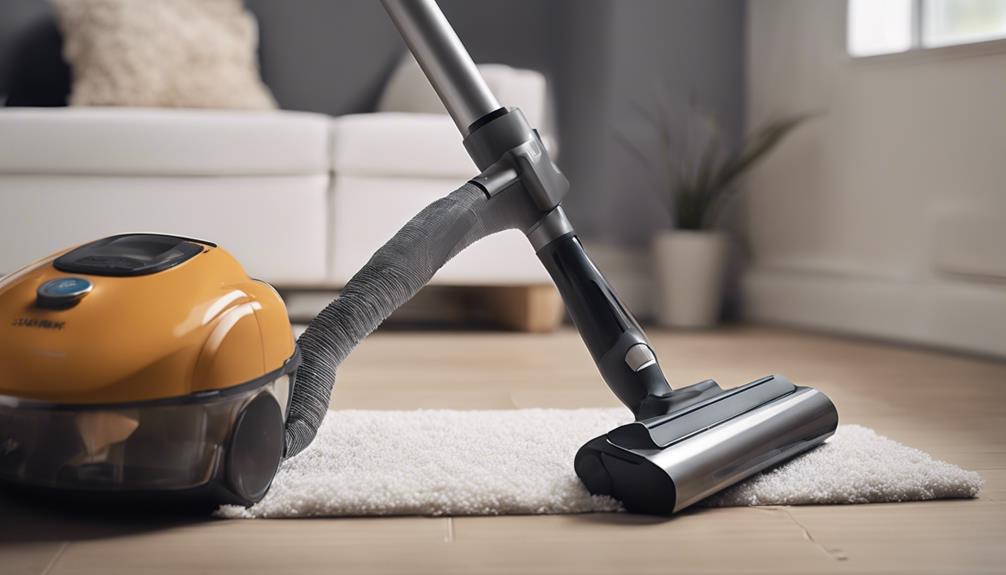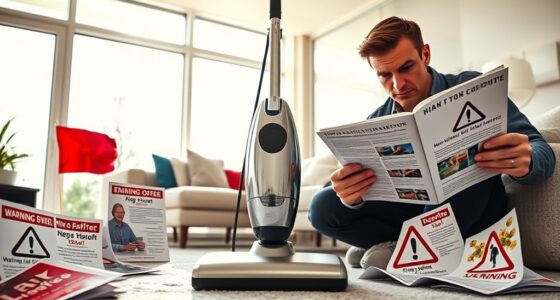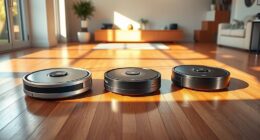Choosing between a bagged or bagless vacuum depends on your cleaning needs, air quality priorities, and budget. Bagged models are great if you want better allergen containment and less cleanup mess, while bagless vacuums offer easy disposal and better convenience for pet hair. Consider how much maintenance you’re comfortable with and your environmental impact. To find out which type fits your household perfectly, explore more detailed comparisons below.
Key Takeaways
- Bagged vacuums excel at allergen containment and are ideal for allergy sufferers, while bagless models offer easier emptying and pet hair removal.
- Bagged vacuums typically have higher initial costs but lower ongoing maintenance, whereas bagless vacuums may require frequent filter replacements.
- For environments with allergy concerns, sealed systems and HEPA filters in bagged vacuums provide better air quality.
- Bagless vacuums are more convenient for quick, everyday cleaning and are suitable for homes with pets due to easy pet hair disposal.
- Choose based on household needs: bagged for allergy control and less mess, bagless for convenience and frequent use.
Understanding the Basic Differences Between Bagged and Bagless Vacuums

When choosing between bagged and bagless vacuums, understanding their fundamental differences can help you make an informed decision. Bagged vacuums use replaceable bags to trap dust and debris, which simplifies dust disposal and reduces exposure to allergens. When the bag fills, you simply replace it, making maintenance straightforward. In contrast, bagless models rely on a canister or chamber that you empty directly into the trash. This eliminates the need for bag replacement but requires you to handle dust more often, which can be messy or expose you to allergens. The key difference lies in dust disposal: bagged vacuums contain messes within the bag, while bagless models require you to manually empty the chamber. Your choice depends on your preference for maintenance and dust handling. Additionally, some users prefer bagged vacuums due to their hygienic disposal, which minimizes dust escape during emptying. Proper sealing of the bags can further enhance dust containment and reduce allergen release during disposal. Moreover, understanding the filtration systems used can impact overall air quality in your home.
Cost and Maintenance Considerations for Each Type
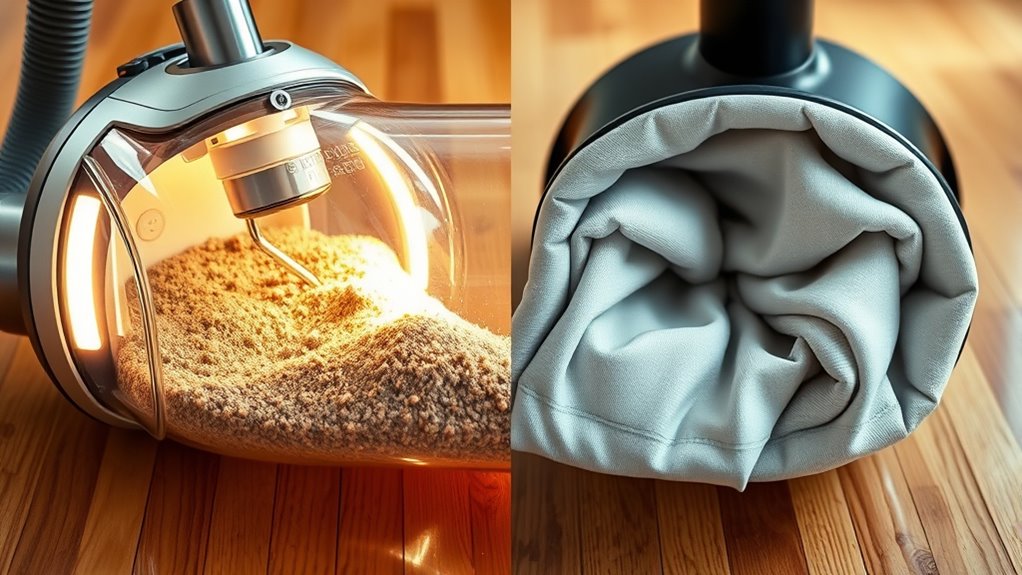
When choosing between bagged and bagless vacuums, your initial cost and ongoing expenses matter. Bagged models often have a higher upfront price but lower maintenance costs, while bagless vacuums usually cost less initially but may require more frequent part replacements. Understanding these costs can help you pick a model that fits your budget and cleaning needs. Additionally, filtration efficiency plays a crucial role in maintaining indoor air quality and can influence long-term health benefits. Considering the suction power and cleaning modes can also impact how effectively each type meets your specific cleaning challenges. Moreover, being aware of cost and maintenance considerations can help you make an informed decision that aligns with your lifestyle and cleaning preferences. It’s also important to evaluate user convenience features like ease of emptying and filter maintenance, which can significantly affect your overall satisfaction with the vacuum.
Upfront Purchase Price
Bagged vacuums typically have a higher upfront cost than bagless models, mainly because they often feature more durable materials and advanced filtration systems. This initial investment can be worthwhile if you prioritize cordless convenience, as many bagged models offer cordless options with easy maneuverability. Additionally, bagged vacuums often come with more extensive warranty coverage, giving you peace of mind for longer periods. While the upfront price might seem steep compared to bagless models, remember that their durability and included warranties can reduce future expenses. If you prefer a vacuum that’s reliable out of the box and offers extended support, a bagged vacuum might be the better choice, especially if you value the convenience of cordless operation and solid warranty coverage. Understanding durability in vacuum models can help you make a more informed decision for long-term use. Moreover, considering the filtration systems can impact overall maintenance costs and health benefits. Investing in high-quality filtration can also contribute to better indoor air quality, which is an important factor for allergy sufferers. Additionally, advancements in automation and smart features are increasingly available in modern vacuum models, offering greater convenience and efficiency.
Ongoing Upkeep Costs
While the initial purchase price is an important factor, considering ongoing upkeep costs helps you understand the true long-term expenses of each vacuum type. Bagged vacuums typically require less frequent filter replacements, which can reduce ongoing costs, but you should also check warranty coverage to see what repairs or parts are included. Bagless vacuums often need more regular filter replacements and may require you to replace the clear canister or seals over time, adding to maintenance costs. Additionally, warranty coverage can vary between models, influencing your out-of-pocket expenses if repairs are needed. Keep in mind that bagless models might save money on bags but could lead to higher filter replacement costs. Evaluating these ongoing expenses helps you choose a vacuum that fits your budget over the long term. Understanding the Kia Tuning options for vehicle performance can provide insights into how maintenance and upgrades impact overall costs. Regular maintenance and filter replacement are essential to prolonging the life of your vacuum and ensuring optimal performance. Moreover, considering the availability of replacement parts can prevent unexpected expenses and extend the lifespan of your appliance.
Cleaning Efficiency and Performance Comparison
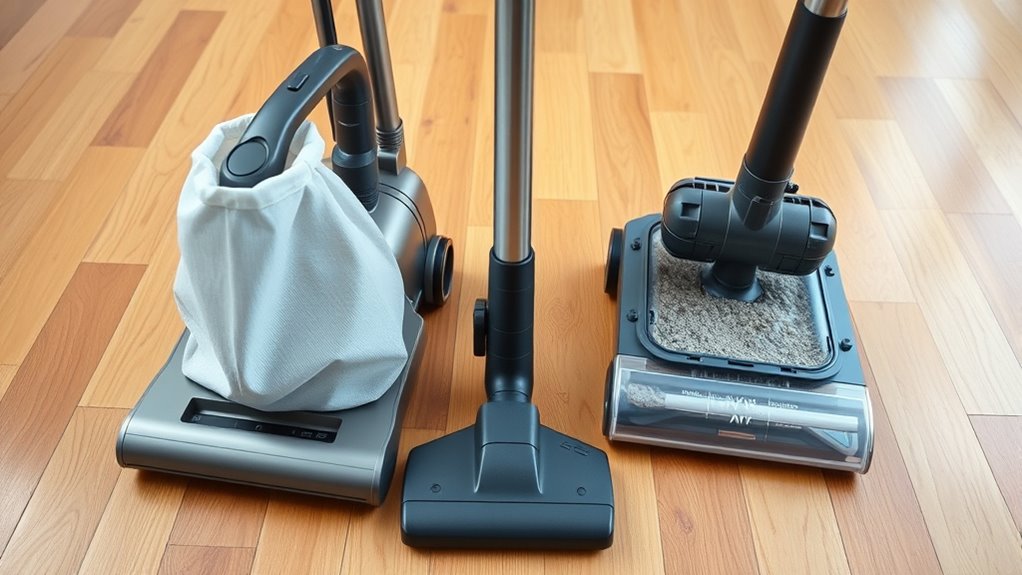
When comparing cleaning efficiency, you’ll want to contemplate how well each vacuum’s suction power picks up dirt and debris. Filtration systems also matter, as they affect air quality and whether allergens are trapped effectively. Understanding these points helps you choose the vacuum that performs best for your cleaning needs. Additionally, the type of filter used, such as HEPA, can significantly impact the vacuum’s ability to effectively capture allergens, ensuring a healthier indoor environment.
Suction Power and Effectiveness
Suction power is a key factor in determining how effectively a vacuum cleans, and both bagged and bagless models can deliver strong performance. When it comes to suction consistency, you’ll notice that some vacuums maintain steady power, ensuring thorough cleaning. The cleaning depth also varies, affecting how well they pick up dirt from deep within carpets. Modern vacuums often include advanced filtration systems that contribute to overall performance and air quality. Consider these points:
- Bagged vacuums often have consistent suction over time, maintaining cleaning depth longer.
- Bagless models may experience fluctuations as the dust container fills, impacting performance.
- Both types can offer high suction power, but your choice depends on how steady you need that power for your surfaces.
- Regular maintenance and filter replacements are essential to preserve vacuum efficiency and optimal suction.
Ultimately, both can be effective, but attention to suction consistency ensures ideal cleaning results.
Filtration and Air Quality
Have you ever wondered how well your vacuum improves indoor air quality? If allergy control is a priority, consider models with HEPA filters. These filters trap tiny particles like pollen, pet dander, and dust mites, preventing them from recirculating into the air. Bagged vacuums often feature sealed systems and HEPA filtration, making them excellent for allergy sufferers. Bagless models, on the other hand, may lose some filtration efficiency if their filters aren’t maintained properly. Regularly replacing or cleaning filters is essential for best possible air quality. Overall, if you want a vacuum that helps reduce airborne allergens, look for one with HEPA filters and a sealed system. Proper filtration directly impacts cleaning efficiency and the air you breathe indoors.
Environmental Impact and Sustainability Factors
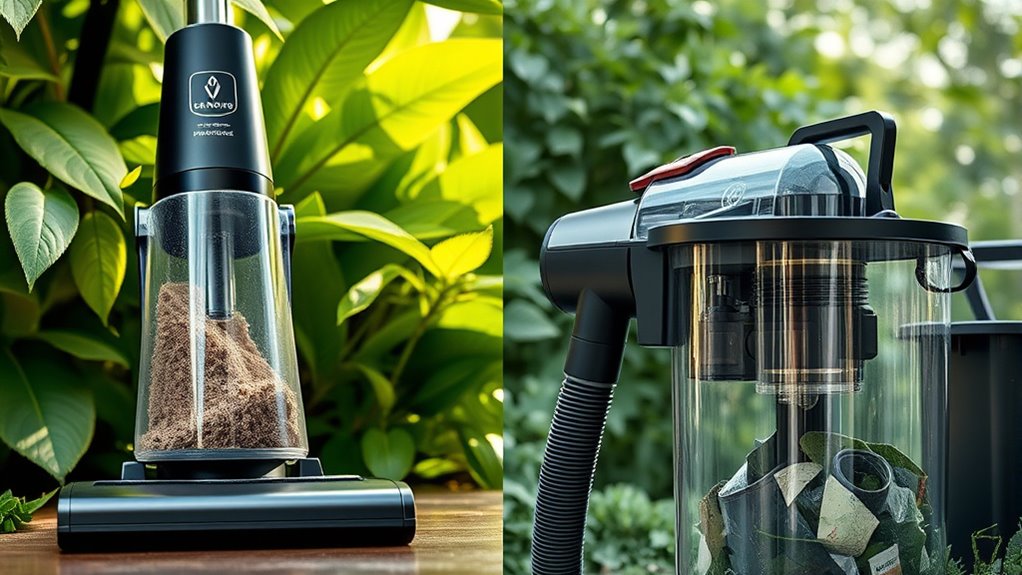
While both bagged and bagless vacuums aim to clean efficiently, their environmental impacts differ substantially. Bagged models often use recyclable materials for their bags, reducing waste, but they generate more landfill waste when discarded. Bagless vacuums, on the other hand, typically have washable filters and can reduce waste over time. However, they may consume more energy during operation due to continuous filter maintenance. Consider these factors:
- Bagged vacuums may produce less plastic waste if bags are recyclable.
- Bagless models can lower landfill contributions but may require frequent filter replacements.
- Energy consumption varies depending on the vacuum’s design and efficiency.
Your choice impacts sustainability: balancing recyclable materials use and energy consumption helps minimize environmental footprint.
Ease of Use and User Convenience
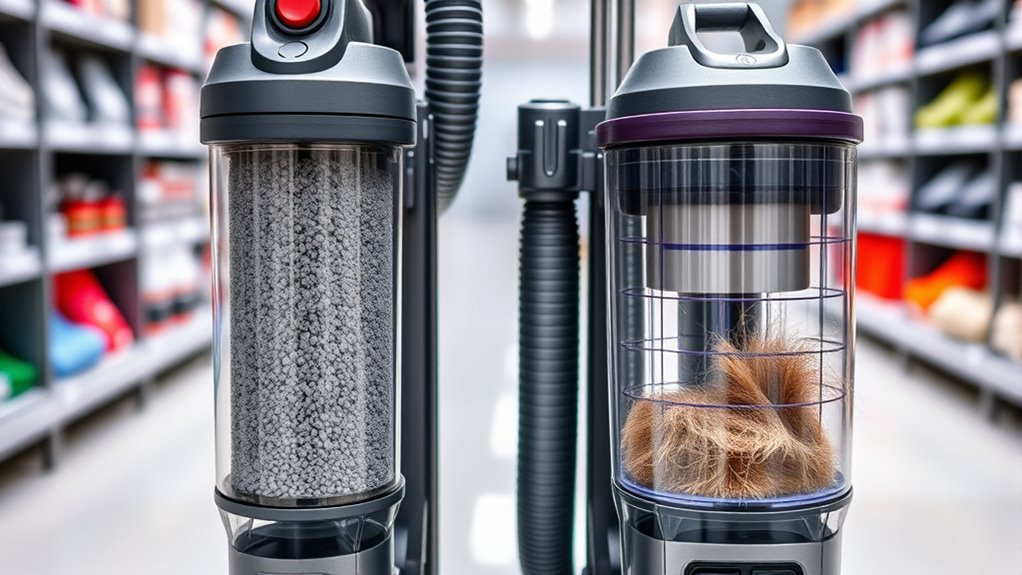
When considering ease of use and user convenience, the design and maintenance features of vacuum types play a significant role. Bagged vacuums often feature ergonomic designs that reduce strain during use, while bagless models typically have straightforward emptying processes. Storage options vary: bagless vacuums usually have compact designs with removable dustbins, making them easy to store. Bagged units may require more space for bags but tend to be lighter and easier to maneuver.
| Feature | Bagged Vacuum | Bagless Vacuum |
|---|---|---|
| Ergonomic Design | Often well-designed for comfort | Varies, but generally lightweight |
| Storage Options | Requires bag storage | Built-in dustbin for quick emptying |
| Maintenance | Needs bag replacement | Emptying dustbin regularly |
| Ease of Use | Less frequent maintenance | Convenient but frequent emptying |
| User Convenience | Less mess with bags | No bags to purchase |
Both offer unique advantages based on your convenience preferences.
Ideal Homes and Specific Cleaning Needs
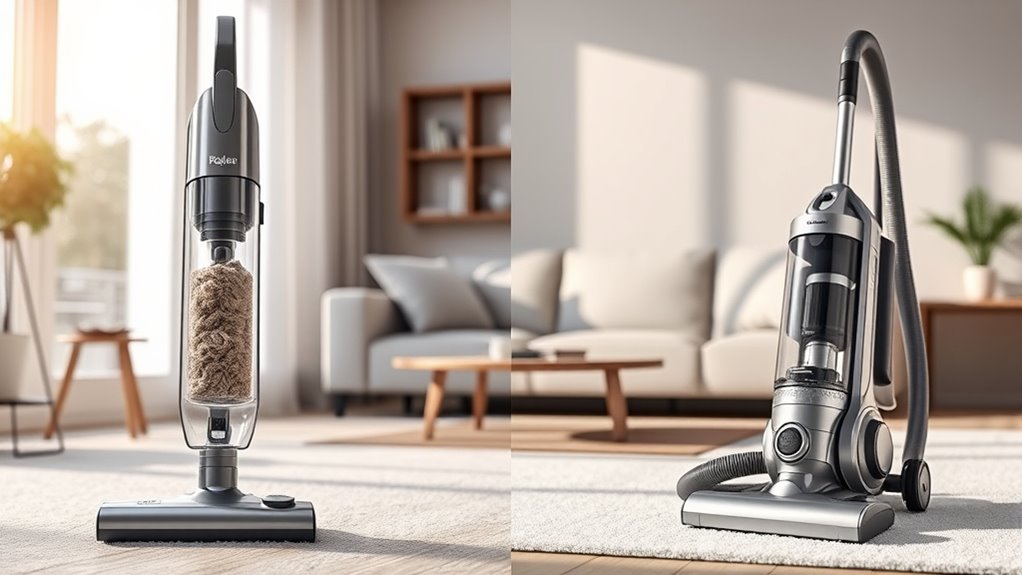
Your choice between bagged and bagless vacuums depends heavily on your home’s layout and specific cleaning challenges. If you have pets, a bagless vacuum can be advantageous because it allows for easy emptying and quick disposal of pet hair and dander. Allergy sufferers may prefer bagged models, as they trap allergens more effectively and reduce dust escape during disposal. Consider these factors:
- Pet owners: Bagless vacuums make it easy to remove pet hair without purchasing replacement bags.
- Allergy sufferers: Bagged vacuums help contain allergens, minimizing exposure during emptying.
- Homes with multiple floors: Opt for a vacuum with adjustable settings suited for different surfaces and height clearance.
Matching your home environment and cleaning needs ensures your vacuum works efficiently and keeps your space healthier.
Making the Right Choice for Your Household
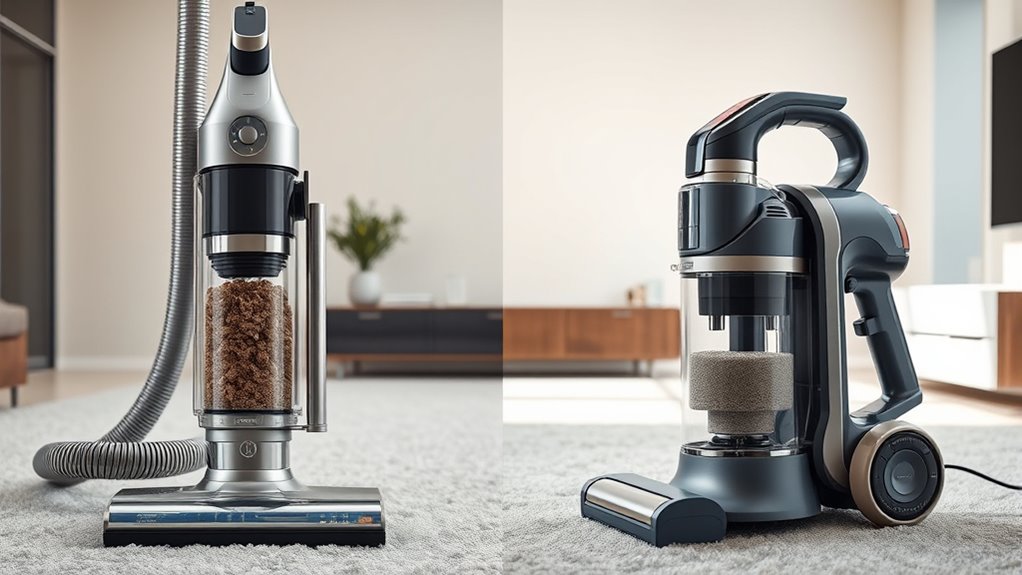
Choosing between a bagged and bagless vacuum depends on how your household functions and what you prioritize in cleaning. If you value convenience and quick maintenance, a bagless model with cordless options might be ideal, especially if you need to move freely around your home. Cordless vacuums are great for quick cleanups and tight spaces. If you have pets, consider how each type handles pet hair—bagged vacuums often trap hair better and reduce mess, while bagless models let you see when they need emptying. Think about your home’s layout, your cleaning frequency, and whether you prefer less ongoing cost or lower upfront expense. Making the right choice guarantees your vacuum fits your lifestyle and keeps your home clean without hassle.
Frequently Asked Questions
Are Bagged Vacuums Better for Allergy Sufferers?
If you’re an allergy sufferer, bagged vacuums are often better due to their allergy-friendly design. They contain dust more effectively, reducing airborne particles during disposal. With dust containment inside the bag, you minimize exposure to allergens like pollen and pet dander. This helps keep your home cleaner and healthier, especially if you have sensitivities. So, choosing a bagged vacuum can make a significant difference in managing allergy symptoms.
How Often Do Bagless Vacuums Need Filter Replacement?
Think of your bagless vacuum’s filter as a busy gatekeeper—its filter lifespan depends on how often you vacuum and the dirt you pick up. Typically, you should replace the filter every 3 to 6 months, but if you notice reduced suction or increased dust, it’s time sooner. Regular filter replacement keeps your vacuum working efficiently, ensuring peak performance and cleaner air in your home.
Can Bagless Vacuums Lose Suction Over Time?
Yes, bagless vacuums can lose suction over time. As dust capacity fills up, airflow decreases, reducing suction power. Regular maintenance, like emptying the dustbin and cleaning filters, helps prevent this. If you neglect maintenance frequency, dirt and debris can clog filters and pathways, causing suction loss. To keep your vacuum performing well, empty the dustbin often and check filters frequently, especially if you notice decreased cleaning efficiency.
Which Vacuum Type Is Quieter During Operation?
Think of a vacuum as a whispering wind—some are quieter than others. When comparing noise levels, bagged vacuums often have better sound insulation, making them quieter during operation. Bagless models tend to produce more noise due to their design and motor exposure. If you prefer a calmer cleaning experience, opt for a bagged vacuum, as it generally offers a more peaceful sound environment.
Do Bagged Vacuums Require Professional Maintenance?
You might wonder if bagged vacuums need professional service. Generally, they require less frequent maintenance, often just replacing the bag and filters. However, if you encounter motor issues or complex repairs, professional service becomes necessary. Regular maintenance like changing bags and filters is straightforward, but for detailed repairs, scheduling professional service guarantees your vacuum stays in top shape. This way, you keep your vacuum running smoothly with minimal hassle.
Conclusion
Choosing between a bagged and bagless vacuum depends on your cleaning style and preferences. While bagless models save money on replacement bags, they might require more frequent filter cleaning. If you dislike messes or allergy concerns, a bagged vacuum could be better. Ultimately, consider your home’s size and your convenience needs. Don’t let initial costs deter you—investing in the right vacuum makes cleaning easier and more efficient in the long run.
